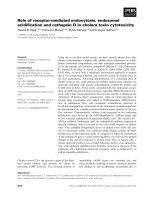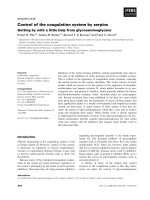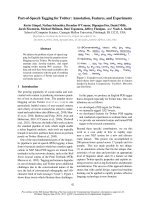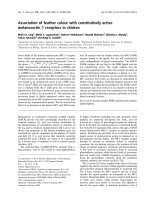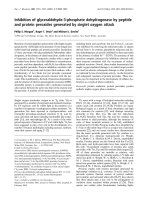báo cáo khoa học: " Control of mandibular incisors with the combined Herbst and completely customized lingual appliance - a pilot study" ppsx
Bạn đang xem bản rút gọn của tài liệu. Xem và tải ngay bản đầy đủ của tài liệu tại đây (306.99 KB, 4 trang )
RESEA R C H Open Access
Control of mandibular incisors with the combined
Herbst and completely customized lingual
appliance - a pilot study
Dirk Wiechmann
1†
, Rainer Schwestka-Polly
2†
, Hans Pancherz
3†
, Ariane Hohoff
4*†
Abstract
Background: The traditional Herbst appliance induces mandibular incisor proclination independent of the
anchorage system used. The dental effects of the Herbst appliance as an element of a completel y customized
lingual orthodontic (LO) appliance (Incognito, 3 M) has not been analyzed yet and the aim of this paper was to
measure the effect of mandibular incisor proclination using this Herbst-LO device.
Methods: Retrospective study. Inclusion criteria: a) Class II ≥ 5 mm molar relationship; b) Herbst appliance ≥ 9
months in situ; and c) finished active treatment. Incisor position was measured on digital models before treatment,
on the digital target setup, and on digital models obtained at the day of debonding. All measurements were
performed by one investigator.
Results: Twelve patients (8 females, 4 males) out of 632 cases treated with a lingual appliance were included in
the study. The measurement error computed with Dahlberg’s formula was 0.2°. Seven cases had planned (target
setup) mandibular incisor uprighting (ccr), and five cases had proclination (clockwise rotation). There was no
statistical difference (p > 0.05) between planned incisor rotations of the target setup and achieved incisor rotations
at the day of debonding. The overall mean difference was 2.2° ± 1.0°.
Conclusions: The Incognito-Herbst combination is the first Herbst device with full control over mandibular incisor
movement. Using this system, anchorage loss or anchorage gain is independent of the Herbst treatment. It
depends only on the planned tooth position of the individual target setup.
Background
Treatment using H erbst telescopes can be expected to
have different effects. For instance, 87% of overjet reduc-
tion is due to dento-alveolar effects, where 47% of the
effect can be found in the maxilla and 40%, in the
mandible [1]. The proclination of the lower incisors,
too, adds to this; after six months into treatment, it may
amount to a mean 6.6° [2]. This is undesirable insofar as
Angle class II associated with mandibular retrognathism
is compensated for in many cases by as little as mandib-
ular incisor proclination.
This treatment-induced proclination, called anchorage
loss, has been the issue of various modifications to the
appliance attempting to minimize it. So far, sev eral
kinds of anchorage have been described: premolar
anchorage, premolar-molar anchorage, pelott anchorage,
labial-lingual anchorage, class III elastics, splint-type
anchorage, and acrylic-type with occlusal co verage [3-5].
The splint-type and the acrylic-type anchorage designs
were believed to achieve the best outcomes as all ante-
rior teeth are fitted with brackets and full- size archwires
in the case of the former, while in the latter, the teeth
are set bodily into plastic material.
Weschler and Pancherz, in their research into various
kinds of anchorage, point out matter-of-factly, “Mandib-
ular anchorage loss in Herbst treatment is a reality with
which the orthodontist has to live. Against all expecta-
tions, the cast splint anchorage was not superior“ [4]. A
systematic review of 2007 reveals the same result:
anchorage loss cannot be avoided and mean proc lina-
tions of 3.2° - 4.5° are observed even with splint-type
and acrylic-type designs [6].
* Correspondence:
† Contributed equally
4
Department of Orthodontics, Westfälische Wilhelms-Universität Münster,
Germany
Wiechmann et al. Head & Face Medicine 2010, 6:3
/>HEAD & FACE MEDICINE
© 2010 Wiechmann et al; licensee BioMed Central Ltd. This is an Op en Access article distributed under the terms of the Creative
Commons Attribution License ( which permits unrestricted use, distribution , and
reproduction in any medium, pr ovided the original work is properly cited.
It is all the more surprising that the Herbst appliance
combined with a customized bracket system was
observed not to exhibit this proclination of the anterior
teeth and–quite the opposite–to even result in ancho-
rage gain amounting t o 7° [7]. This isolated case raised
the issue as to whether this was a lucky accident or
whether the proclination, unavoidable so far, could be
managed by a precisely designed combination of slot
and full-size archwire. To answer this question, the first
cases of t reatment with this new, combined device have
now been analyzed.
Methods
632 patients treated with an individually customized lin-
gual bracket system (Incognito, 3 M) were scre ened to
be enrolled into this study The criteria of inclusion
were: a) Angle class II ≥ 5 mm molar relationship; b)
Herbst appliance in situ for a minimum of nine mont hs;
and c) active treatment completed.
For every single treatment, the Incognito system works
with a case-individual prescription, which is the result of
the pretreatment malocclusion and the individual setup,
i.e., the desired treatment outcome. As a consequence,
all included cases represent their own, individual
prescription.
That is why, to assess effects o n the proclination of
the anterior teeth, the pro-/inclination present as part of
the setup has to be considered. For this reason anterior
tooth inclination was measured pretreatment (t1) on the
scanned casts, as per setup (t2), and with completed
active treatment (t3).
To establish a reproducible reference plane, landmarks
were placed on the midpoints of the visible crowns of
canines, premolars, and molars and a horizontal plane
was constructed with minimal vertical distance to these
landmarks (Figure 1). For measurements the models’
postero-anterior plane was oriented to the right-hand
side and the most prominent incisor was sectioned par-
allel to this plane. Incisor torque was measured between
the horizontal reference plane and the longitudinal axis
of the tooth c rown. Incisor reclination was represented
as a counter-clockwise (CCW) rotation (negative values)
of the tooth axis in the sagittal plane. Incisor proclina-
tion was represented as a clockwise rotation (positive
values).
To calculate the measurement error one investigator
performed replicated incisor measurements on 20 mod-
els at two different times. All measurements were taken
with the Rhinoceros® NURBS modeler (Robert McNeel
& Associates, Woodland Park Avenue North, Seattle
WA, U.S.A.). Statistical analysis (descriptive, regression
analysis, non-parametric Kru skal-Wallis test) was per-
formed with R [8].
Results
Based on the incl usion criteria 12 patients (8 femal es, 4
males) were allocated to the study. At the day of
debonding their mean age was 18.6 ± 7.4 years ( female:
20.8 ± 8.3 (median 16.2); male: 14.3 ± 1.6 (median
13.6)).
All measurements were performed by one investigator.
The measurement error computed with Dahlberg’sfor-
mula [9] was 0.2°. The maximal range between repeate d
measurements was 1.2°.
Figure 2 shows the distribution of the planned (mal-
occ-setup) and the achieved (malocc-end) mandibular
incisor movement. Seven cases were planned with man-
dibular incisor CCW rotation (mean value = -7.7°) and
five cases, with CW rotation (mean value = 3.6°). On
the day of debonding all planned incisor movements
were achieved except for case 8 where a CCW rotation
of -2.1° was planned and a CW rotation of 0.2° was
finally measured. The mean difference betwe en planned
(malocc-setup) and final incisor rotations (malocc-end)
was 2.2° ± 1.0°. However, no statistical difference
Figure 1 Top: Planned tooth position of Incognito’s setup with
virtual Herbst telescopes attached. Middle: Landmarks placed on
the midpoints of the visible crowns (canines, premolars, and molars
only) to construct a reproducible reference plane for incisor torque
measurements. Bottom: Visual representation of the reference plane.
Wiechmann et al. Head & Face Medicine 2010, 6:3
/>Page 2 of 4
(p > 0.05) was found between planned and final incisor
rotations.
There was a wide range of pla nned incisor move-
ments, ranging from -16.5° to 5.8°, with two cases
(10, 3) with a CCW rotation of more than 13° (Figure 2).
For case 10 the planned rotation (-16.5°) was nearly
achieved with an undercorrection of 1°, whereas case 3
(13.3° planned) showed an overcorrection of 4.5°. There
is no relation between the amount of incisor rotation
and the amount of under- or overcorrection (Adjusted
R-squared: 0.29). Age has no effect either on the
amount of movement (Adjusted R-squared: -0.09).
Discussion
Up until now there has been an agreement in the litera-
ture that anchorage loss in the form of mandibular inci-
sor CW rotation/proclination during Herbst treatment
is a reality and cannot be prevented by any anchorage
sys tem combined with the Herbst appliance. This paper
has been able to show that by using the Incognito’s
Herbst system, not only could anchorage loss be pre-
vented, but also anchorage gain (in the form of mandib-
ular incisor reclination) could be achieved.
Looking at the anchorage provided by a traditional
Herbst appliance, the level of anchorage which a
Herbst-LO appliance is able to provide is higher. Its
full-arch and full-size, rectangular archwires and the
reverse-torque effect on the lower anterior teeth are the
reason for this higher level, since the bracket is located
posterior to the centre of resistance, which in turn
results in a reverse moment of force to which the
arc hwire is exposed. Still higher levels of anchorage can
be achieved by using one or a combination of the fol-
lowing: stiffer wires, reverse third-order bends with pre-
programmed reverse torque, bracket and pivot bases
linked to each other.
Themajordifferencebetweenthisstudyandother
retrospective Class II evaluation studie s is that only
models were used for analysis, instead of lateral head
films. Lateral head films would clearly be able to show
mandibular incisor inclination before and a fter treat-
ment, but unable to provide a ny information on the
planned movements. The Incognito’s workflow depends
on a target plaster cast setup incorporating desir ed pro-
clination, if any; but if incisor proclination is d esired/
planned (which was the case 5 times in this study), a
mere before-after comparison of head films woul d have
biased the f inal result because any proclination would
have been interpreted as a side effect (anchorage loss)
rather than as a p lanned movement. Therefore , the
asse ssment in this study was based on a reference plane
obtained from reproducible landmarks on the digital
models. The measurement error of the m ethod was 0.2°
and had no effect on the results.
A limiting factor of this study is its retrospective nat-
ure and the small number of patients included. The
Herbst appliance in Lingual Orthodontics was first
described in 2008 [7]. Only a few finished cases are
available for analysis as of today and clinically controlled
trials do not exist yet. Further investigation based on
the presented method is needed to finally verify our pre-
liminary results.
Conclusions
Considering the retrospective nature of the study and
the small number of patients included , the following
conclusions could be drawn.
1. The Incognito system allows precise torque con-
trol with a mean error of 2.2° ± 1.0° between
planned (target setup) and final (day of debonding)
tooth position.
2. The Incognito system is able to prevent anchorage
loss (mandibular incisor proclination) during Herbst
treatment.
3. The Incognito system is able to gain anchorage
(mandibular incisor reclination) during Herbst
treatment.
4. Using the Incognito system anchorage loss or
anchorage gain is independent of the Herbst treat-
ment. It depends only on the pl anned tooth position
in the target setup.
5. The Incognito-He rbst combination is the first
Herbst device with full control over mandibular inci-
sor movement.
Figure 2 Distribution of the planned (malocc-setup), the
achieved (malocc-end), and the difference between planned
and achieved incisor rotations (setup-end). Negative values
represent a counter-clockwise rotation (reclination), positive values, a
clockwise rotation (proclination) of the mandibular incisor in the
postero-anterior plane.
Wiechmann et al. Head & Face Medicine 2010, 6:3
/>Page 3 of 4
Author details
1
Private Practice, Bad Essen, Germany.
2
Department of Orthodontics,
Medizinische Hochschule Hannover, Germany.
3
Department of Orthodontics,
University of Giessen, Germany.
4
Department of Orthodontics, Westfälische
Wilhelms-Universität Münster, Germany.
Authors’ contributions
HP initiated the investigation, participated in discussions on the undertaking
of the study, interpreted the data and reviewed all iterations of the paper.
DW and AH designed the study. AH and RS analyzed the data. DW and RS
supervised the clinical sample and data collection. DW treated all cases. AH
and DW wrote the main part of the paper. RS contributed to writing the
paper and reviewed the paper for content. All authors approved the final
manuscript.
Competing interests
DW is the inventor of the Incognito-System and the founder of the former
manufacturing company of Incognito which was acquired by 3 M Unitek.
DW is working in private practice and not a member or associate of 3 M. All
other authors have no competing interests.
Received: 2 December 2009 Accepted: 11 March 2010
Published: 11 March 2010
References
1. Ruf S, Pancherz H: Orthognathic surgery and dentofacial orthopedics in
adult Class II Division 1 treatment: mandibular sagittal split osteotomy
versus Herbst appliance. Am J Orthod Dentofacial Orthop 2004,
126:140-152.
2. Pancherz H: The Herbst appliance-its biologic effects and clinicaluse. Am
J Orthod 1985, 87:1-20.
3. Pancherz H, Hansen K: Mandibular anchorage in Herbsttreatment. Eur J
Orthod 1988, 10(2):149-164.
4. Weschler D, Pancherz H: Efficiency of three mandibular anchorage forms
in Herbst treatment: a cephalometric investigation. Angle Orthod 2005,
75:23-27.
5. Franchi L, Baccetti T, McNamara JAJ: Treatment and posttreatment effects
of acrylic splint Herbst appliance therapy. Am J OrthodDentofacial Orthop
1999, 115(4):429-438.
6. Flores-Mir C, Ayeh A, Goswani A, Charkhandeh S: Skeletal and dental
changes in Class II division 1 malocclusions treated with splint-type
Herbst appliances. A systematic review. Angle Orthod 2007, 77(2):376-381.
7. Wiechmann D, Schwestka-Polly R, Hohoff A: Herbst appliance in lingual
orthodontics. Am J Orthod Dentofacial Orthop 2008, 134(3):439-446.
8. R Development Core Team: R: A Language and Environment for
Statistical Computing. R Foundation for Statistical Computing, Vienna,
Austria 2009, [].
9. Dahlberg G: Statistical methods for the medical andbiological students.
Allen and Unwin 1940.
doi:10.1186/1746-160X-6-3
Cite this article as: Wiechmann et al.: Control of mandibular incisors
with the combined Herbst and completely customized lingual
appliance - a pilot study. Head & Face Medicine 2010 6:3.
Submit your next manuscript to BioMed Central
and take full advantage of:
• Convenient online submission
• Thorough peer review
• No space constraints or color figure charges
• Immediate publication on acceptance
• Inclusion in PubMed, CAS, Scopus and Google Scholar
• Research which is freely available for redistribution
Submit your manuscript at
www.biomedcentral.com/submit
Wiechmann et al. Head & Face Medicine 2010, 6:3
/>Page 4 of 4


